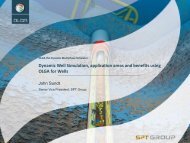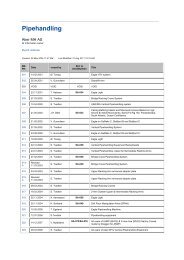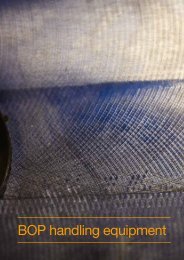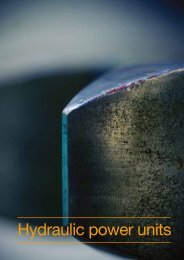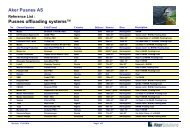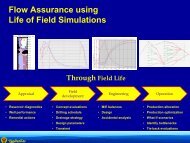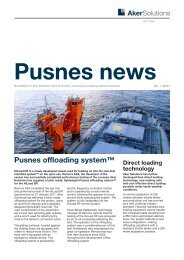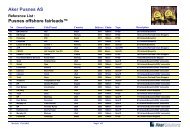Sulphuric Acid Concentration - Aker Solutions
Sulphuric Acid Concentration - Aker Solutions
Sulphuric Acid Concentration - Aker Solutions
You also want an ePaper? Increase the reach of your titles
YUMPU automatically turns print PDFs into web optimized ePapers that Google loves.
<strong>Sulphuric</strong> <strong>Acid</strong> <strong>Concentration</strong><br />
In the early seventies, <strong>Aker</strong> <strong>Solutions</strong> engineers set out to improve the sulphuric acid concentration<br />
process by building upon their knowledge and experience with Nitric <strong>Acid</strong> <strong>Concentration</strong>.<br />
<strong>Aker</strong> Chemetics, A division of <strong>Aker</strong> <strong>Solutions</strong> Canada Inc. © 2011 <strong>Aker</strong> <strong>Solutions</strong><br />
Suite 200 – 2930 Virtual Way, Vancouver, British Columbia, Canada V5M 0A5<br />
Tel +1 604 734 1200 Fax +1 604 734 0340 www.akersolutions.com/chemetics<br />
For more information please contact us at spent.acid@akersolutions.com<br />
Using modern, reliable materials such as glass lined steel, PTFE,<br />
Tantalum and Zirconium the engineers at <strong>Aker</strong> <strong>Solutions</strong><br />
developed the patented vacuum evaporation process that still<br />
forms the heart of our technology today. This process is<br />
characterized by the extensive use of gravity flow to transfer hot<br />
acid between the various process steps and by the use of natural<br />
circulation thermosyphon loops for the acid evaporators. These<br />
natural circulation evaporators allow high heat transfer rates,<br />
large turndown, minimize fouling and avoid the use of pumps in<br />
hot acid service which improves both safety and reliability.<br />
Multiple stages are used for large capacities or for large<br />
increases in concentration.<br />
In 1975, after extensive pilot plant work, the first modern <strong>Aker</strong><br />
<strong>Solutions</strong> <strong>Sulphuric</strong> <strong>Acid</strong> <strong>Concentration</strong> plant was designed and<br />
built for the Air Products DNT facility in Texas where it continues<br />
to operate today. Since that time, the design and technology<br />
have continued to improve and more than 40 spent acid plants<br />
have been delivered to satisfied clients around the globe.<br />
Completed plants range in capacity from 25 to 2200 MTPD and<br />
concentrate sulphuric acid from a starting concentration as low as 7 wt% to product concentrations<br />
between 83 to 96 wt% sulphuric acid.<br />
Although the <strong>Aker</strong> <strong>Solutions</strong> Evaporator System forms the<br />
heart of every process, it is very important to incorporate into<br />
each plant the appropriate pre-treatment of the spent acid to<br />
remove (and recover) impurities and to minimize effluent.<br />
<strong>Aker</strong> <strong>Solutions</strong> has developed several additional process<br />
options that can be used to provide a custom made process<br />
for each spent acid. Examples are hydrolysis or striping<br />
processes to remove organics, Fractionation columns to<br />
concentrate and recover valuable by-products and NOx<br />
absorption systems to clean vent gases prior to discharge.<br />
<strong>Aker</strong> <strong>Solutions</strong> carries out extensive safety reviews and<br />
operates a testing facility to ensure that optimum conditions<br />
are selected for each spent acid. This approach has resulted<br />
in safe and reliable plants with availabilities well above 95%.<br />
For more information please contact us to discuss your <strong>Sulphuric</strong> <strong>Acid</strong> <strong>Concentration</strong> requirements.
<strong>Sulphuric</strong> <strong>Acid</strong> <strong>Concentration</strong> background<br />
The concentration of <strong>Sulphuric</strong> acid provides a number of technical challenges/choices that must be<br />
carefully managed in order to create an economic and reliable process.<br />
<strong>Sulphuric</strong> acid can be concentrated by boiling the<br />
solutions as water evaporates preferentially. The graph<br />
on the left shows the atmospheric boiling point of<br />
sulphuric acid at various concentrations: It is clear that<br />
high temperatures are required to obtain concentrated<br />
acid. When the required temperature exceeds the<br />
temperature of the available heat source (normally steam)<br />
and/or the temperature limits (approx. 200°C) of the<br />
available materials of construction, it is necessary to carry<br />
out the concentration under vacuum. The vacuum levels<br />
used in practice are further constraint by the desire to<br />
condense the water that has been removed from the acid<br />
using normal cooling water. The result is a practical lower operating limit of approx 100 mbara.<br />
As can be seen on the right, using 10 barg steam it is<br />
possible to concentrate up to ~85 wt% at an operating<br />
pressure of 100 Bara. If 20 barg steam is used, the<br />
maximum possible concentration at 100 mbara pressure<br />
increases to ~90 wt%. For even higher concentrations it is<br />
necessary to operate at a lower pressure and the use of<br />
chilled water to condense the overhead vapours is<br />
required.<br />
At high concentrations a further complicating factor<br />
comes into play. As the acid concentration increases, the<br />
vapours removed from the boiling liquid consist not only<br />
of water vapour, but also contain an increasing amount of sulphuric acid vapour (as shown in the<br />
graph below) until the azeotrope is reached at 98.3 wt% H2SO4:<br />
<strong>Aker</strong> Chemetics, A division of <strong>Aker</strong> <strong>Solutions</strong> Canada Inc. © 2011 <strong>Aker</strong> <strong>Solutions</strong><br />
Suite 200 – 2930 Virtual Way, Vancouver, British Columbia, Canada V5M 0A5<br />
Tel +1 604 734 1200 Fax +1 604 734 0340 www.akersolutions.com/chemetics<br />
For more information please contact us at spent.acid@akersolutions.com<br />
Based on this graph it can be concluded that acid<br />
concentrations up to approx 89 wt% are possible with<br />
acceptable acid losses to the overhead vapour and no<br />
special precautions have to be taken to prevent corrosion<br />
of the overheads condensing system or recover the acid<br />
lost from the system.<br />
At higher concentrations additional process equipment is<br />
required to remove and recover the sulphuric acid from<br />
the overhead vapour. Generally a packed column is used<br />
to contact the vapours with a dilute sulphuric acid liquid<br />
stream causing the acid vapours to be selectively<br />
removed after which the water vapour can be condensed in the overheads condensing system.<br />
Due to the presence of the azeotrope at ~98 wt% H2SO4 concentration it is not practical to concentrate<br />
to a product concentration that exceeds 97 wt% H2SO4. If a higher concentration is required, it is<br />
possible to fortify the acid further using either SO3 gas or Oleum.



